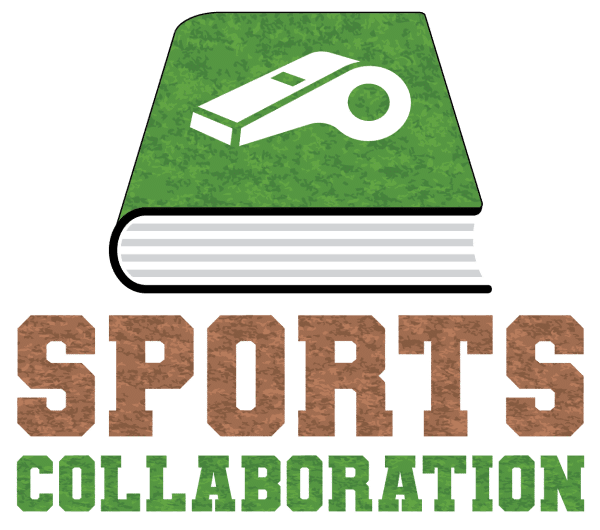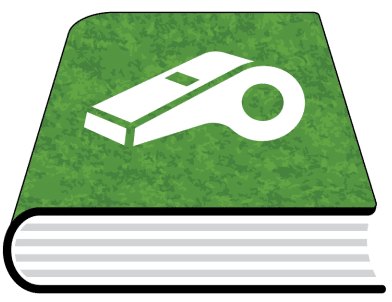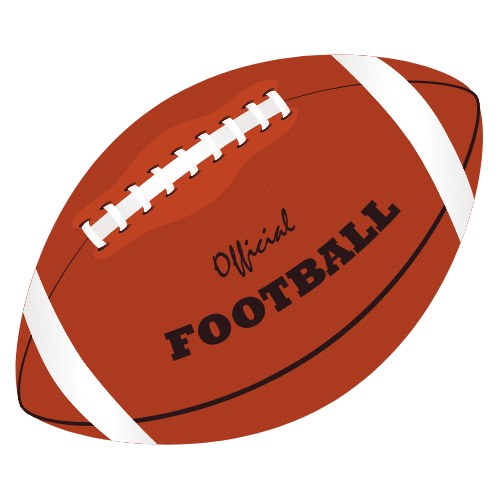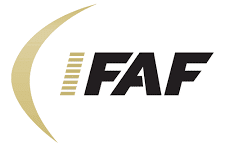Rule 1 - The Game, Field, Players and Equipment
SECTION 4. Players and Playing Equipment
Article 1 - Recommended Numbering
It is strongly recommended that offensive players be numbered according to the following diagram that shows one of many offensive formations:
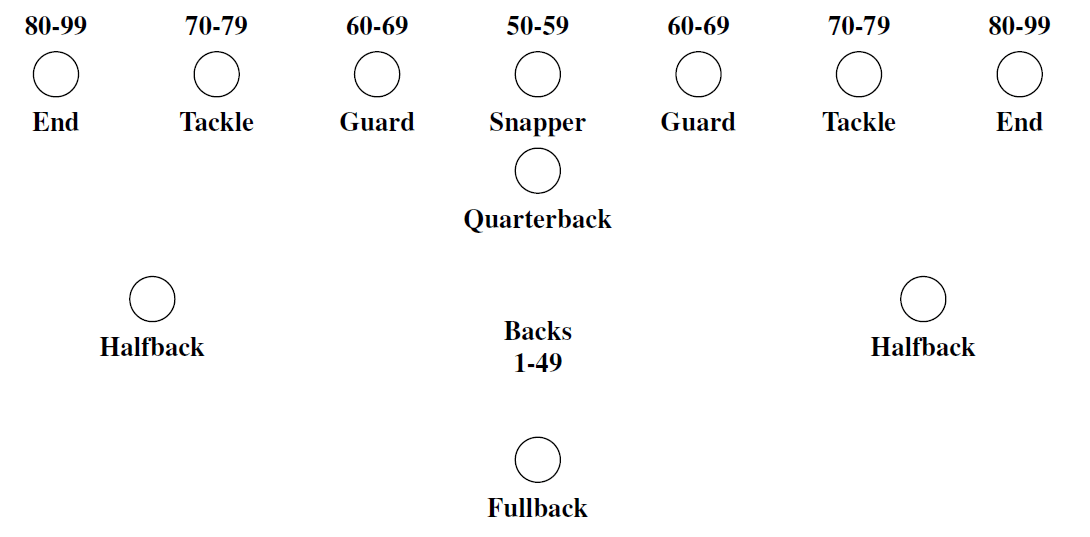
Article 2 - Players’ Numbering
a. All players shall be numbered 0 through 99. Any number preceded by the digit zero such as "099", "07" or "00" is illegal.
b. No more than one squad member may be assigned or wear the same jersey number (Rule9-2-2-f).
c. Markings in the vicinity of the numbers are not permitted.
PENALTY − [a&c] Live-ball foul. Five yards from the previous spot [S23: IPN].
d. When a player enters the game after changing their jersey number or with a different number than on the game day roster, the player must report to the referee. The officiating crew informs the opposing head coach and the referee announces the change. A player who enters the game after changing their number or with a different number than on the game day roster and does not report commits a foul for unsportsmanlike conduct. (A.R. 1-4-2:I)
PENALTY − [d] Live-ball foul. 15 yards from the previous spot [S27: UC-UNS].
Flagrant offenders shall be disqualified [S47: DSQ].
Article 3 - Mandatory equipment
All players must wear the following mandatory equipment:
a. Helmet.
b. Hip pads.
c. Jersey.
d. Knee pads.
e. Mouthpiece.
f. Pants.
g. Shoulder pads.
h. Socks.
i. Thigh guards.
Article 4 - Specifications: Mandatory Equipment
a. Helmets.
1. The helmet must be fitted with a facemask and a secured four- or six-point chin strap, all points of which must be secured whenever the ball is in play.
2. Helmets for all players of a team must be of the same colour and design.
3. Helmets must carry a warning label regarding the risk of injury and a manufacturer’s or reconditioner’s certification indicating satisfaction of National Operating Committee on Standards for Athletic Equipment (NOCSAE) test standards. Reconditioned helmets shall show recertification to indicate satisfaction with the NOCSAE test standard.
b. Hip pads. Hip pads must include a tailbone protector.
c. Jersey. See Rule 1-4-5.
d. Knee pads. Knee pads must be covered by pants. Furthermore, the pants and knee pads must cover the knees. No pads or protective equipment may be worn outside the pants. (See Appendix E.)
e. Mouthpiece. The mouthpiece must be an intra-oral device of any readily visible colour. It must not be white or transparent. It must be made with FDA-approved base materials (FDCS) and cover all upper teeth. It is recommended that the mouthpiece be properly fitted.
f. Pants. Players of a team must wear pants of the same colour and design.
g. Shoulder pads. There are no specifications for shoulder pads. (See Appendix E.)
h. Socks. Players of a team must wear socks or leg coverings that are identical in colour and design. (Exception: Unaltered knee braces, tape or a bandage to protect or prevent an injury, and barefoot kickers)
i. Thigh guards. There are no specifications for thigh guards. (See Appendix E.)
AR 1-4-4
Article 5 - Jersey Design, Colour and Numerals
a. Design
1. The jersey must have sleeves that completely cover the shoulder pads. It must not be altered or designed to tear. The jersey must be full-length and tucked into the pants or made even with the waistline. No other undergarment (e.g., T-shirt) shall extend below the waistline at the torso. It must cover all pads worn at or above the waist. A second jersey meeting all requirements of Rule 1-4-5 worn concurrently is allowed. Vests and/or altered jerseys with zippers, Velcro, clasps or other fasteners are not allowed.
2. Other than the player’s numbers, the jersey may only contain:
• Player’s name in Latin script;
• Team name in Latin script;
• Mascot name;
• Sleeve stripes;
• Logo for team, competition mascot, game memorial, or the military;
• Authorised advertising material;
• The letter "C" to identify a team captain; or
• The team’s national flag.
3. Any item in paragraph 2 must not exceed 16 square inches in area (i.e., rectangle, square, parallelogram), including any additional material (e.g. patch).
4. A border around the collar and cuffs not more than 1 inch wide is permissible, as is a maximum 4-inch stripe along the side seam (insert from the underarm to pants top).
5. Jerseys may not be taped or tied in any manner.
b. Colour.
1. Players of opposing teams shall wear jerseys of contrasting colours. Players on the same team shall wear jerseys of the same colour and design.
2. The visiting team shall wear white jerseys; however, the home team may wear white jerseys if the teams have agreed in writing before the start of the competition.
3. If the home team wears coloured jerseys, the visiting team may also wear coloured jerseys, if and only if the following conditions have been satisfied:
(a) The home team has agreed in writing prior to the game; and
(b) The competition authority certifies that the jersey of the visiting team is of a contrasting colour.
4. If on the kickoff at the start of each half, either team wears a coloured jersey in violation of the conditions specified above, it is a team foul for unsportsmanlike conduct.
PENALTY − Administer as a dead-ball foul. 15 yards at the succeeding spot following the kickoff. If the kickoff is returned for a touchdown, the penalty is assessed either on the try or on the succeeding kickoff, at the option of the home team. [S27: UCUNS] In addition, officials shall charge a team timeout at the start of each quarter the illegal jerseys are worn, or a foul for delay of the game if all timeouts have been used.
5. If a coloured jersey contains white, it may appear only as any of the items listed in paragraph a-2 above.
c. Numerals.
1. The jersey must have clearly visible, permanent Arabic numerals measuring at least 8 and 10 inches in height front and back, respectively. The number must be of a colour that itself is clearly in distinct contrast with the colour of the jersey, irrespective of any border around the number. The number must be centred. No logo may appear within 1 inch of the numerals.
2. Teams wearing jerseys/numerals that do not conform to this rule will be asked to change into legal jerseys before the game and before the start of the second half. On the kickoff at the start of each half, if a team wears a jersey in violation of the conditions specified in paragraph 1, it is a foul for unsportsmanlike conduct.
PENALTY − Administer as a dead-ball foul. 15yards at the succeeding spot following the kickoff. If the kickoff is returned for a touchdown, the penalty is assessed either on the try or on the succeeding kickoff, at the option of the offended team. [S27:UC-UNS] In addition, officials shall charge a team timeout at the start of each quarter the illegal jerseys are worn, or a foul for delay of the game if all timeouts have been used.(A.R. 1-4-5:I)
3. All players of a team shall have the same colour and style numbers front and back. The individual bars must be approximately 1½ inches wide. Numbers on any part of the uniform shall correspond with the mandatory front and back jersey numbers.
Article 6 - Optional equipment
The following items are legal:
a. Towels and hand warmers.
1. Solid colour towels no smaller than 4 inches by 12 inches and no larger than 6 inches by 12 inches with no words, symbols, letters, or numbers. Towels may bear the team logo. They may also contain a single manufacturer’s or distributor’s normal label or trademark not to exceed 2-¼ square inches in area. Towels that are not a solid colour are not permitted.
2. Hand warmers worn during inclement weather.
b. Gloves.
1. A glove is a fitted covering for a hand having separate sections for each finger and thumb, without any additional material that connects any of the fingers and/or thumb, and that completely covers each finger and thumb. There is no restriction on the
colour of gloves.
2. Gloves should have a securely attached label or stamp ("NF/NCAA Specifications") indicating voluntary compliance with appropriate test specifications on file with either the Sports and Fitness Industry Association (SFIA) or the National Operating
Committee on Standards for Athletic Equipment (NOCSAE), unless made of unaltered plain cloth.
c. Eye shields. Eye shields must be clear, not tinted, and made from moulded or rigid material. Eyeglasses and goggles also must be clear and not tinted. No medical exceptions are allowed.
d. Insignia.
1. Persons or events may be memorialised by an insignia with an area not greater than 2.25 square inches on the uniform or helmet.
2. Team/national decals and advertising are allowed on helmets.
e. Eye shade. Any shading under a player’s eyes must be solid black with no words, numbers, logos or other symbols.
f. Game information. Any player may have written game information on the wrist, arm or belt.
Article 7 - Illegal equipment
Illegal equipment includes the following (see Appendix E for additional details):
a. Equipment worn by a player that could endanger other players.
b. Tape or any bandage other than that used to protect an injury, subject to the approval of the umpire.
c. Hard, abrasive or unyielding equipment that is not completely covered and padded, subject to the approval of the umpire.
d. Cleats that extend more than ½ inch from the base of the shoe (See Appendix E for full specifications).
e. Any equipment that could confuse or deceive an opponent.
f. Any equipment that could provide an unfair advantage to any player.
g. Adhesive material, paint, grease or any other slippery substance applied to equipment or on a player’s person, clothing or attachment (Exception: Eye shade (Rule 1-4-6-e)).
h. Uniform attachments other than towels (Rule 1-4-6-a).
i. Rib pads, shoulder pad attachments and back protectors that are not totally covered. (A.R. 1-4-7:II)
j. Visible bandannas worn on the field outside the team area. (A.R. 1-4-7:I)
k. Jerseys that do not conform with Rule 1-4-5.
l. Non-standard overbuilt facemask. (A.R. 1-4-7:IV) (See Appendix E for examples.)
m. Equipment that has been modified in a way that reduces the protection of the player wearing it or any other participant.
n. Hoodies, if the hood is outside the shoulder pad and overlapping the jersey.
Article 8 - Mandatory and Illegal Equipment Enforcement
a. No player wearing illegal equipment or failing to wear mandatory equipment shall be permitted to play. (Exception: Rule 1-4-5-c).
b. If an official discovers illegal equipment, or if a player is not wearing mandatory equipment, the player must leave the game for at least one down and is not allowed to return until the equipment is made legal. The player may be allowed to return without
missing a down if the team takes a charged team timeout, but in any event the player may not play with illegal equipment or without mandatory equipment.
c. If equipment becomes illegal through play, the player is not required to leave the game for one down, the player he may not participate until the equipment is made legal. (A.R. 1-4-7:II)
d. If an official notifies a player to leave the field, but the player does not respond by doing so after two notifications, a timeout shall be charged to the team. Each of the first three infractions in a half carries a charged team timeout, if timeouts are available. Any infractions after a team has exhausted its timeouts is a foul for delay of game and carries a five-yard penalty. (A.R. 1-4-8:IV).
1. If a timeout is available, it is granted. When timeouts are exhausted, the next infraction is a dead-ball delay penalty at the succeeding spot.
2. A timeout is called, the offending team is indicated by the referee, then the captains and head coach are notified through the officials nearest to them.
3. Equipment timeouts are not limited by the prohibition on consecutive team timeouts (Rule 3-3-4) but the additional one minute is not granted.
Article 9 - Coaches’ Certification
The head coach or his designated representative shall certify in writing to the umpire before the game that all players:
a. Have been informed what equipment is mandatory by rule and what constitutes illegal equipment.
b. Have been provided with the equipment mandated by rule.
c. Have been instructed to wear and how to wear mandatory equipment during the game.
d. Have been instructed to notify the coaching staff when equipment becomes illegal through play during the game.
Article 10 - Prohibited Signal Devices
Players may not be equipped with any wearable electronic, mechanical or other signal devices for the purpose of communicating with any source or recording sound or vision. (Exceptions:
1. A medically prescribed hearing aid of the sound-amplifier type for hearing-impaired players.
2. A device for transmission or reception of data specifically and only for the purposes of health and safety.)
PENALTY − Administer as a dead-ball foul, 15 yards at the succeeding spot. Player is disqualified. [S7, S27, S47: UC-UNS/DSQ].
Article 11 - Prohibited Field Equipment
Jurisdiction regarding the presence and location of communication equipment (cameras, sound devices, etc.) within the playing enclosure resides with game management personnel.
a. Photographs (digital or otherwise), computers and other electronic communication devices are permitted for coaching purposes during the game or between periods. They may not be used in the field of play or end zones.
1. Game management is responsible for assuring identical television capability and identical video and Internet connectivity in the team area and in the coaches’ booths of both teams.
2. Teams are responsible for their own computers or other coaching equipment.
3. A monitor is permitted on the sideline only to assist team or game management medical personnel in the diagnosis and treatment of participants.
b. Only voice or text communication between the press box and team area is permitted. Where press-box space is not adequate, only voice or text communication may originate from any area in the stands between the 20-yard lines extended to the top of the stadium. No other communication for coaching purposes is permitted anywhere else, including the use of any communication equipment (e.g. mobile phones or radios) for voice, text, image or any other type of message from inside or outside the playing enclosure by or to any person subject to the rules.
c. Media communication or recording equipment, including cameras, sound devices, computers and microphones, is prohibited on or above the field, or in or above the team area (Rule 2-31-1).
Exceptions:
1. Camera equipment attached to a goal support behind the uprights and crossbar.
2. Camera(s) embedded in any pylon.
3. A camera, with no audio component, may be attached to the cap of any official with prior approval of the official and the participating teams.
NOTE: Cameras worn by officials solely for the purposes of officiating development may be worn by any official without requiring the permission of the participating teams.
4. A camera, with no audio component, may be attached to cables that extend over the team area and field of play, including the end zones.
5. A team videographer may be in the team area as one of that team’s 25 credentialed individuals. This video may not be used during any live broadcast or digital stream of the game.
d. Drone (uncrewed aerial vehicle) use is prohibited for any purpose, including videoing the game, during the period of the officials’ jurisdiction (Rule 11-1-1) or otherwise when squad members are present within the playing enclosure.
1. No drone may be flown within the area bounded by the stadium, dome, stands, fences or other structures. Where there is no stadium, dome or stands, no drone may be flown within 165 yards (150 meters) of any area occupied by participants or spectators.
2. If a drone violates this space or otherwise poses a danger to participants or spectators, the referee shall order the game stopped until such time as the drone is removed from the space.
e. Microphones attached to coaches during the game for media transmission or recording are prohibited.
f. No one in the team area or coaching box may use any artificial sound amplification for communication.
g. Any attempt to record, either through audio or video means, any signals given by an opposing player, coach or other team personnel is prohibited.
Article 12 - Coaches' Phones
Coaches’ phones and headsets are not subject to playing rules penalties before or during the game.
a. ∅ A competition may develop a policy to provide guidance in handling situations dealing with failure of coaches’ headsets.
Article 13 - Referee communication
a. § A microphone is strongly recommended for the referee to be used for all game announcements. It is strongly recommended that it be a lapel-type microphone. The microphone must be controlled by the referee. It may not be open at other times.
b. A wireless communication system open only to the officiating crew, video judge and the officiating observer is permitted.
c. No person subject to the rules is permitted to eavesdrop wireless communication between officials before, during or after the game.
PENALTY − For fouls before or during the game, administer as a dead-ball foul, 15 yards at the succeeding spot. Person is disqualified. Fouls after the game shall be reported as misconduct.
Article 14 - Accessibility
a. In the interests of accessibility, national federations may approve on a case-by-case basis applications to:
1. permit a participant to use prosthetics during games
2. permit a reasonable adjustment to the uniform and equipment rules for a disabled participant
3. permit a person to participate in a gender different to that assigned to them at birth
b. To be approved, it must be demonstrated via a risk assessment that this:
1. does not pose an undue risk to the participant
2. does not pose any additional risk to other participants
3. does not convey an unfair competitive advantage to the participant or their team
c. Approvals must be notified to potential opponents and relevant officials. Approvals must be notified to IFAF in the case of people who intend to participate in international competitions.
